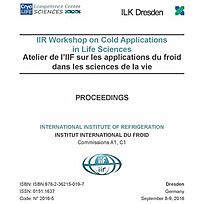
Document IIF
Comparaison entre l'efficacité de la vitrification et celle de la congélation lente pour les zygotes humains.
Comparison of vitrification and slow freezing efficiencies of human zygotes.
Numéro : pap. 018
Auteurs : PETRUSHKO M. P., PYNYAEV V. I., YURCHUK T. A.
Résumé
The use of cryopreservation of embryos in assisted reproduction technologies can not only reduce the occurrence rate of multiple pregnancies, but also increases the cumulative pregnancy rate, due to embryo transfer in any other cycle with no stimulation of superovulation. Due to this the cryopreservation procedures objective is to obtain a high rate of survival and viability of embryos after thawing, which largely depends on the choice of freezing method. Since one of the key parameters of cryopreservation protocols is the rate of cooling, the aim of this study was to compare the efficacy of slow freezing and vitrification of human embryos at the zygote stage. There was shown that the most effective zygote cryopreservation was at 18 hrs. after insemination, when 2 pronuclei were clearly visualized. At this time, the early zygotes were less sensitive to the damaging effects of freeze-thawing process than the zygotes were in G2 phase of the cell cycle, the stage which was prior to mitosis (26 hrs. after insemination). The further development of these zygotes was blocked. Our data are helpful in explaining the conflicting results about successful or failed cryopreservation of human embryos at the zygote stage.
Documents disponibles
Format PDF
Pages : 4 p.
Disponible
Prix public
20 €
Prix membre*
Gratuit
* meilleur tarif applicable selon le type d'adhésion (voir le détail des avantages des adhésions individuelles et collectives)
Détails
- Titre original : Comparison of vitrification and slow freezing efficiencies of human zygotes.
- Identifiant de la fiche : 30019505
- Langues : Anglais
- Source : 2nd IIR Workshop on cold applications in life sciences.
- Date d'édition : 08/09/2016
- DOI : http://dx.doi.org/10.18462/iir.cals.2016.0018
Liens
Voir d'autres communications du même compte rendu (25)
Voir le compte rendu de la conférence
Indexation
- Thèmes : Influence du froid sur les cellules, tissus et organes
- Mots-clés : Vitrification; Cryobiologie; Comparaison; Rendement; Embryon; Cryoconservation; Congélation
-
Cryopreservation by vitrification: basic thermo...
- Auteurs : KATKOV I. I., BOLYUKH V. F.
- Date : 15/05/2017
- Langues : Anglais
- Source : Cryogenics 2017. Proceedings of the 14th IIR International Conference: Dresden, Germany, Mai 15-19, 2017.
- Formats : PDF
Voir la fiche
-
Low temperature photo pyroelectric study on the...
- Auteurs : MATHEW A., ESCORNE B., ELASS A., et al.
- Date : 15/05/2017
- Langues : Anglais
- Source : Cryogenics 2017. Proceedings of the 14th IIR International Conference: Dresden, Germany, Mai 15-19, 2017.
- Formats : PDF
Voir la fiche
-
Low- and high-temperature vitrification of livi...
- Auteurs : KATKOV I. I.
- Date : 27/04/2004
- Langues : Anglais
- Source : Cryogenics 2004. Proceedings of the 8th Cryogenics Conference
- Formats : PDF
Voir la fiche
-
Cryopreservation of mesenchymal stromal cells b...
- Auteurs : PETRENKO A. Ju., TRUFANOVA N. A., PETRENKO Ju. A.
- Date : 11/09/2012
- Langues : Anglais
- Source : Cryogenics 2012. Proceedings of the 12th IIR International Conference: Dresden, Germany, September 11-14, 2012.
- Formats : PDF
Voir la fiche
-
Cryopreservation of mutant mice.
- Auteurs : SCHENKEL J., DIERCKS A. K., STAUDT M., et al.
- Date : 07/04/2014
- Langues : Anglais
- Source : Cryogenics 2014. Proceedings of the 13th IIR International Conference: Prague, Czech Republic, April 7-11, 2014.
- Formats : PDF
Voir la fiche
